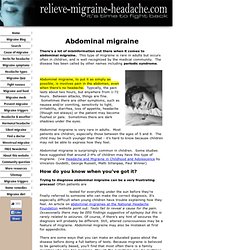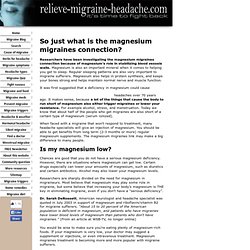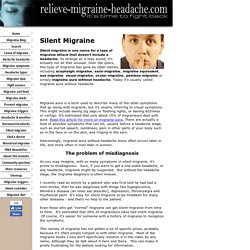

Neuroscience For Kids. The smell of a flower - The memory of a walk in the park - The pain of stepping on a nail.

These experiences are made possible by the 3 pounds of tissue in our heads...the BRAIN!! Neuroscience for Kids has been created for all students and teachers who would like to learn about the nervous system. Discover the exciting world of the brain, spinal cord, neurons and the senses. Use the experiments, activities and games to help you learn about the nervous system. There are plenty of links to other web sites for you to explore. Can't find what you are looking for? Portions of Neuroscience for Kids are available in Spanish, Slovene, Portuguese, Italian, Korean, Japanese, Serbian, Russian, Slovak, Romanian, Polish, Albanian, Czech, Finnish, Estonian, Hungarian, Punjabi, Indonesian, Malay, Norwegian, Ukranian and Turkish.
"Neuroscience for Kids" is maintained by Eric H. Menstrual Migraine: How "Mini-Prophylaxis" Can Work for Your Patient - Psychiatric Times. Magnesium and migraine headache. Alternative Mental Health. Abdominal migraine. There's a lot of misinformation out there when it comes to abdominal migraine.

This type of migraine is rare in adults but occurs often in children, and is well recognized by the medical community. The disease has been called by other names including periodic syndrome. Abdominal migraine, to put it as simply as possible, is involves pain in the abdomen, even when there's no headache. Typically, the pain lasts about two hours, but anywhere from 1-72 hours. Between attacks, things are fine. Abdominal migraine is very rare in adults. Abdominal migraine is surprisingly common in children. How do you know when you've got it? Abdominal Migraine.
The magnesium migraines connection – the key to ending your headache? Researchers have been investigating the magnesium migraines connection because of magnesium's role in stabilizing blood vessels walls.

Magnesium is also an important mineral when it comes to helping you get to sleep. Regular sleeping patterns are also very important to migraine sufferers. Magnesium also helps in protein synthesis, and keeps your bones strong and helps maintain normal nerve and muscle function. It was first suggested that a deficiency in magnesium could cause headaches over 70 years ago.
When faced with a migraine that won't respond to treatment, many headache specialists will give an injection of magnesium. Is my magnesium low? Chances are good that you do not have a serious magnesium deficiency. Researchers are sharply divided on the need for magnesium in migraineurs. Dr. You would be wise to make sure you're eating plenty of magnesium-rich foods. Normal adults require about 310-420mg of magnesium daily. Symptoms of low magnesium... What can I eat to boost my magnesium? Headache causes, news, types and treatments - find answers and fight back! Headache and Migraine News. IHS - International Headache Society» Home. Silent Migraine. Silent migraine is one name for a type of migraine attack that doesn't include a headache.

As strange as it may sound, it's actually not all that unusual. Over the years, this type of migraine has gone by other names, including acephalgic migraine, sans-migraine, migraine equivalent, eye migraine, visual migraine, ocular migraine, painless migraine or simply migraine aura without headache. Today it's usually called migraine aura without headache. Migraine aura is a term used to describe many of the other symptoms that go along with migraine, but it's usually referring to visual symptoms. This might include seeing zig zags or flashing lights, or having dizziness or vertigo. Interestingly, migraine aura without headache more often occurs later in life, and more often in men than in women.
The problem of misdiagnosis As you may imagine, with so many symptoms in silent migraine, it's prone to misdiagnosis. Even those who get "normal" migraine can get silent migraine from time to time. Summary. Atypical migraine aura.